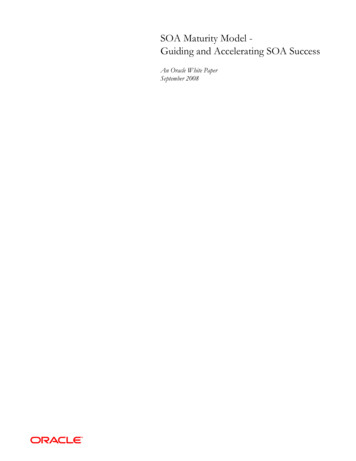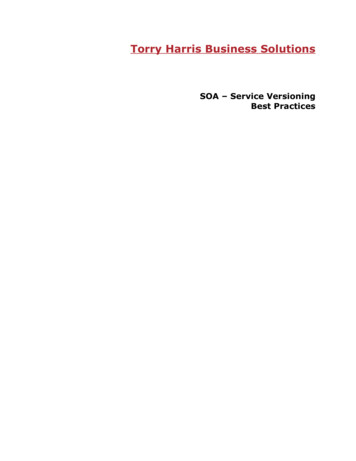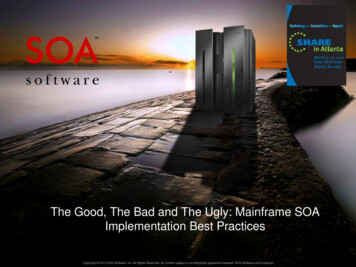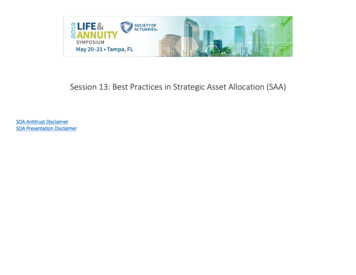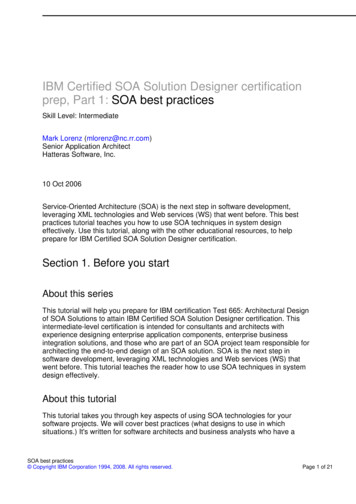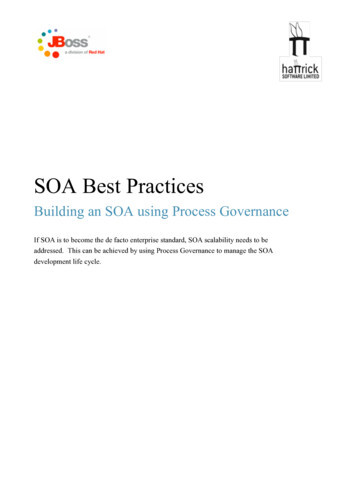
Transcription
SOA Best PracticesBuilding an SOA using Process GovernanceIf SOA is to become the de facto enterprise standard, SOA scalability needs to beaddressed. This can be achieved by using Process Governance to manage the SOAdevelopment life cycle.
BackgroundAlthough the mere mention of Service Orientated Architecture (SOA) is sufficient to attract the attention of most ITmanagers this is still an early stage market. For SOA to continue up the adoption curve, SOA implementations need tobe delivered faster, and managing complex processes over loosely coupled, fragmented systems needs to be simplified SOA needs to become scalable. Until SOA scalability can be demonstrated, adoption by the late-majority users is likelyto remain contained.Difficulties with SOA scalability are being experienced in a number of areas with customers and practitionerstypically raising concerns relating to: the time and resource required to generate a system specification ambiguously defined system specifications resulting in a high occurrence of implementation errors the poor visibility of the overall implementation resulting in complexities in on-going systemmaintenance the inability to ensure conformance of the executing process against the originating specifications the requirement to assess the impact of an implementation change prior to the alteration of codeThe generation of a system specification is problematic. Currently the business analysts document the interactionsbetween co-operating services using a standard graphics package with explanatory notes being attached typicallygenerated in MS-Word. As business processes become more complex, maintaining control and visibility of the requiredmessage exchanges using these tools becomes more difficult. As complexity increases, ambiguity in the systemspecification compounds, resulting in implementation errors.The containment of implementation errors is being addressed by continuous testing at each stage of the build, withnumerous adjustments being made until the required system outputs are achieved. If SOA is to scale, this bespokeprocess of fashioning, fitting and refashioning needs to be industrialised. To achieve this three enhancements to currentpractices are required: the introduction of a formal link between the design time and run-time to ensure the deliveredimplementation is aligned with the originating requirements continuous validation of the executing events to ensure the implementation remains aligned with thespecification provision of overall visibility of the inter-dependencies between co-operating services to assess theimpact of an implementation change before such change is introducedThe current approach to delivering an SOA system specification lacks formal validation that the system design willdeliver the required business result. This ambiguity is compounded by the absence of a formal link between the designand the implementation phases, with the potential result that the implemented system may not deliver the requiredprocess.2
Design-Time Process GovernanceThe concept of Design-Time Process Governance represents the ability to provide formal links across the variousphases of the SOA development life cycle in a manner that enables each phase to be validated against the originatingrequirements.Gather Business RequirementsThe first phase is to document the requirements. To ensure these requirements may be validated against theimplementation, these need to be described in a machine-processable manner. To achieve this, the requirements aregathered in two categories: example business messages illustrating the interactions to be passed around the system, andexample scenarios detailing the alternative paths the process may follow.By way of example, one scenario may represent a customer completing a transaction, following a successful creditcheck: whilst the alternative path may be an unsuccessful transaction resulting from a credit check fail. Thesealternative execution paths, or “scenarios” are documented using enhanced sequence diagrams, the enhancement beingthe attachment of example messages to each interaction that are later used to validate the implementation. A simplepurchasing example illustrating alternative execution paths is shown in Diagram 1 below:Scenario 1: Successful transactionScenario 2: Unsuccessful transactionDiagram 1: Example enhanced scenario diagrams showing alternate possible execution paths with example messages attached the eachinteractionProcess DesignThe next step is to build the Process Design by creating or re-using the type definitions for the example messagesand the dynamic behaviour defined in the scenarios. If the example messages are XML based, the message type can bedefined using an XML schema. To describe the dynamic behaviour, the type definition can be represented using achoreography description language, for example CDL.For the purpose of clarity, the term “choreography” describes the interactions between a set of participating servicesfrom a neutral or “global” perspective. This is not to be confused with the concept of orchestration, which provides adescription of behaviour only from a service specific perspective.An example of a choreography description of the Process Design, illustrating the two scenarios detailed inDiagram 1 is provided below:3
Diagram 2: Global description of the required message sequencing for the two example scenariosOnce the type definitions have been defined, the example messages are used to validate the scenarios. This ensuresthe type definitions correctly represent the originating requirements. This is an important step, as the type definitionswill be subsequently used to implement the system. This provides the validation link between the scenarios describedin the requirements gathering phase which in turn represent the business requirements. In circumstances where XMLbased example messages are used, validating parsers may be used to ensure that the example messages conform to theXML schema.The choreography description is validated by simulating the execution paths using the example messages assigned inthe scenarios. Below is an example of a scenario displaying a validation error - in this case buy(BuyConfirmed)following a checkCredit(CreditCheckInvalid) message response:Diagram 3: Scenario displaying an error as a result of an incorrectly described type definition - in this casean incorrect behavioural sequencing4
Where errors are detected, the system architect needs to determine whether the choreography description or thescenario is incorrect. If the scenario has been signed off by the business, as representing a valid use case, the systemarchitect needs to revalidate the scenario with the business to ensure it has been correctly described. If this is the case,the choreography description requires adjustment to reflect the required use case.Once the choreography description of the Process Design has been validated as correct, it may be exported to avariety of formats including BPMN, UML activity/state diagrams and HTML for review and sign off.Evaluating Existing ServicesOnce the Process Design has been validated, the system architect needs to identify the services that are available forre-use, those that may be re-used but require modification and those services that need to be constructed. To achievethis the system architect needs to understand the specific behaviour required of each service in the context of theProcess Design. This is obtained from the Process Design using a technique called “endpoint projection”. Thisgenerates the endpoint behavioural description for each service.In the above example, the endpoint behavioural description of the Store service is represented as follows:Receive BuyRequest from Buyer;Send CreditCheckRequest to CreditAgency;choice {Receive CreditCheckOk from CreditAgency;Send BuyConfirmed to Buyer;} or {Receive CreditCheckFailed from CreditAgency;Send BuyFailed to Buyer;}The endpoint behavioural description is used to interrogate the Service Repository and identify the availability ofservices that either match, or partially match the required behaviour. In cases where there is only a partial match, a gapanalysis needs to be performed to determine whether it is appropriate to modify the existing service or build a newversion.Service DesignFor services that need to be developed, the endpoint behavioural description can be used to generate a template ofthe Service Design using BPMN, UML state diagrams, and other representations. This Service Design may then beelaborated by a designer, to provide further detail regarding the internal implementation of the service. The followingexample displays the BPMN template for the Store service in the above example:Diagram 4: BPMN template for Store service5
Dependent upon the notation used to document the Service Design, it may be possible to validate the Service Designagainst the service's endpoint behavioural description derived from the Process Design, to ensure that the designconforms to the expected behaviour - although this is not currently possible using BPMN or UML unless strictconventions are followed by the designer, to enable the communication behaviour to be derived.Service ImplementationWhen a service is ready to be implemented, skeletal code for the implementation is able to be generated from eitherthe endpoint behavioural description or the Service Design.An example of WS-BPEL code generated from the endpoint behavioural description of the Store service would be: process name "Store". . sequence receive createInstance "yes" operation "buy" partnerLink "Store"portType "tns:Store"/ scope faultHandlers catch faultName ”tns:CreditCheckFailed” reply faultName "tns:BuyFailed" operation "buy"partnerLink "Store" portType "tns:Store"/ /catch /faultHandlers sequence invoke operation "checkCredit" partnerLink "CreditAgency"portType "tns:CreditAgency"/ reply operation "buy" partnerLink "Store" portType "tns:Store"/ /sequence /scope /sequence /process As the service implementation evolves, the service's endpoint behavioural description may be used to ensureconformance to the behaviour specified by the Process Design.As the Process Design has been validated against the originating requirements, thus provides full behaviourtraceability from requirements through to implementation, although this may only be achieved where theimplementation language enables the communication structure to be derived (as in WS-BPEL, jPDL, and JBossESBconversational actions).Service TestingOnce the services have been implemented, modified or existing services located in the Service Repository, thescenarios are used to perform Service Unit Testing.Where the scenario shows a message being sent to a service, a service unit test harness is used to deliver the examplemessage specified in the scenario, to the service. Where the scenario shows a message being sent by a service, themessage can be intercepted by the service unit test harness and compared against the expected example message asspecified in the scenario. This ensures the endpoint behavioural description of the service has been correctly described.As the internal behavioural conformance of a service has been validated as it is being developed, this ensures theservice implementation conforms to the originating requirements. Using the example messages specified in thescenarios re-enforces this conformance as an incorrect implementation would result in the service attempting to sendand receive messages at variance with the example messages.6
Service DeploymentOnce the endpoint behavioural description for each service has been validated, the service may be deployed and theendpoint behavioural description recorded at the Service Repository. Once recorded this can be used either insubsequent Process Designs, to locate a service for re-use, or as part of the runtime discovery of a service based on therequired behaviour.Summary - Design Time Process GovernanceDesign Time Process Governance consists of six phases: Gather Requirements Process Design Service Design Service Implementation Service Testing Service DeploymentThe following diagram illustrates these six phases together with the associated inter-locking conformance checkingand generation cycles that ensure the deployed services are aligned with the originating requirements. This shows theuse of Process Governance to generate the service related artifacts and to ensure their continuing conformance with theoriginating requirements as the system evolves through to deployment.Diagram 5: Illustration of the interlocking conformance checking and generation cycles7
Runtime Process GovernanceDesign Time Process Governance enables incompatible behaviour to be detected prior to service deployment, whichin turn contains the risk of runtime processing errors. Runtime Process Governance is required to ensure ongoingvalidation of the process against the originating requirements. This contains the risk of “implementation drift” as theservices are modified and new services introduced.This is achieved by the use of Service Validators deployed to each service. The validators report all serviceinteractions to the Process Correlator which reconstructs the global representation of the transaction using the ProcessDesign. This is illustrated in the following diagram:Diagram 6: Block diagram illustrating the location of Service Validators monitoring service interactions, the ProcessCorrelator comparing these interactions against the Process Design, and the reporting of exceptionsService Behaviour ValidationThe Service Validators monitor the inbound and outbound messages for each service and compares these with theexpected service endpoint behavioural description. In “active” mode, the Service Validators will block out-of-sequenceor unexpected interactions thus protecting the downstream process: in “passive” mode, messaging events, whethercompliant or not with the Process Design are allowed to execute. All interactions, including non-compliant events, arereported to the Process Correlator.8
Process CorrelationThe Process Correlator is a centralised correlation engine. It acts as a repository for the send, receive and errornotifications as reported by the Service Validators and reports variances where the correlated interactions fail to complywith the Process Design.This acts as a conformance validation cycle to ensure the overall SOA implementation is correctly executingaccording to the originating requirements. As all messaging events are reported to the Process Correlator, fine grained,granular visibility of the system is achieved. This includes the collection of messaging time stamps, used to identifyand monitor relevant process performance metrics.The Process Correlator differs from the conventional approach of monitoring each service individually bydetermining end-to-end processing conformance and ensuring compliance with the higher level Process Design. Thisaddresses the shortcomings of specific service monitoring that does not guarantee the detection of non-compliance ormissing interactions that may impact downstream processing.This is illustrated by the recent problems at the opening of Heathrow Airport Terminal 5, London. In this SOAimplementation, whilst each sub-system was functioning as designed, the overall process was not executing as required.In this case, the baggage handling sub-system was activated with a filter in place preventing it from communicatingwith inter-related systems. This prevented the baggage handling system from accessing the delivery destinations for thechecked-in luggage. It returned the luggage to the terminal, resulting in aircraft departures without the passengersbaggage having been loaded. This resulting chaos led to losses estimated at 16 million.Process Governance contains this risk by ensuring the overall runtime behaviour is executing in accordance with the“global” description of the originating requirements.Process MaintenanceProcess Governance performs an important function both during the Design Time and Runtime phases of an SOAproject. It also performs an important function in the Maintenance Phase. Maintaining robust control overimplementation changes across a highly distributed infrastructure is a complex problem and is critical to maintainingoverall system integrity. The following methodology describes how this is achieved using Process Governance.Update Requirements and Process DesignImplementation changes may be specified using the originally generated scenarios or by generating new scenariosto illustrate the required change. Once the scenarios have been updated the Process Design is modified to reflect therequired changes and validated against the scenarios.Implementation Impact AnalysisImplementation Impact Analysis is a static check to identify the potential impact of the proposed changes on thedeployed system. This enables incompatibility between the deployed implementation and the modified implementationto be identified thus reducing the resource required on system testing and the potential for inadvertently introducingruntime errors. An impact analysis needs to be performed in relation to all modified and introduced services todetermine the effect the proposed changes will have on clients of the service. This ensures any updated services are stillable to interact with other services in a manner that is consistent with their endpoint behavioural description. Asservices may be shared across multiple systems, any reference to the service being changed needs to be validated.9
It is important to ensure the Service Repository contains information on all the inter-dependencies between clientsand services otherwise only a partial Implementation Impact Analysis is possible.The benefit of using Process Governance, when introducing implementation change, is that it allows clients of a newor modified service to be analysed in order to determine whether the client’s requirements continue to be met by themodified behaviour. This is achieved by using conformance checking between the client’s required endpointbehavioural description of the service and the actual behaviour provided by the service.Implement and Deploy the Service ChangesOnce the Implementation Impact Analysis is understood, it will be possible to plan the implementation anddeployment of any new and modified services. If the required change is complementary to existing client usage, thenthe service deployment may simply be upgraded.In situations where the change is incompatible with existing client usage, and it is not possible to simultaneouslyupdate the affected clients, then a modified version of the service will need to be deployed along side the existingversion. This should not present any difficulties if service details are “hard-coded” into the relevant clients, to ensurethey access the correct version of the deployed services.However, if dynamic service discovery is used, then Process Governance will be required to ensure the impactedclients are furnished with the correct reference to the appropriate version of the service. This is achieved by the clientsupplying the required endpoint behavioural description when performing the service lookup. The client supplieddescription may be compared against the service description recorded in the Service Repository to ensure conformance.SummaryThis paper describes three enhancements to the delivery of SOA. These enhancements eliminate systemspecification ambiguity and enables SOA adoption to be industrialised across a broad spectrum of early to late-majorityadopters.The introduction of Process Governance delivers the formal linkages currently absent across the multiple stages ofthe SOA development and maintenance life cycles. These formal linkages ensure the resulting system is aligned andremains aligned with the originating requirements.Process Governance may be introduced at any stage of an SOA project. It is possible to use agile softwaredevelopment techniques to implement an SOA and then to reverse engineer the Process Design to act as a referencemodel for testing and verification in order to obtain traceability back to originating requirements “after the fact”. Thisapproach can also be used to document existing SOA implementations in order to obtain ongoing benefits related toimplementation change.10
SOA Best Practices Building an SOA using Process Governance If SOA is to become the de facto enterprise standard, SOA scalability needs to be addressed. This can be achieved by using Process Governance t

